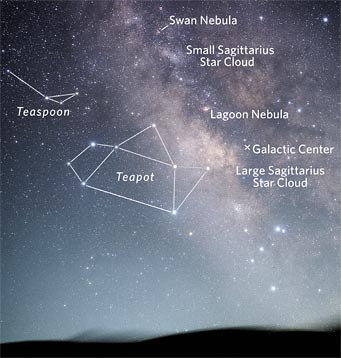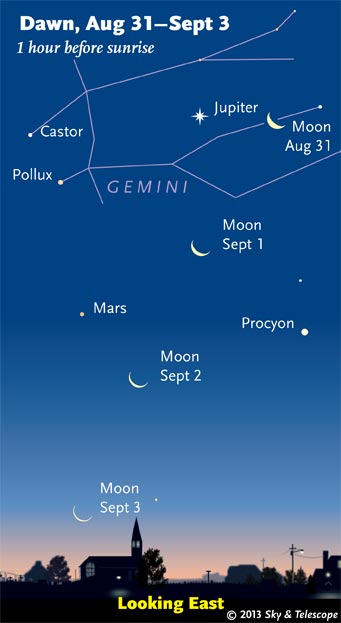Bright nova in Delphinus. For news of the naked-eye nova in the evening sky that first erupted August 14th, see Bright Nova in Delphinus, which includes a finder chart and a link to a continuously updated light curve.
Friday, August 23
Saturday, August 24

The Sagittarius Teapot and the surrounding rich Milky Way are highest in the south right after dark in late August. The brightest puff of the summer Milky Way seems to rise like steam from the Teapot's spout. All of the labeled objects here are good binocular targets under a dark sky. Click the image for a larger view.
Alan MacRobert
Sunday, August 25
Monday, August 26
Tuesday, August 27
Wednesday, August 28
Thursday, August 29

As dawn brightens, watch the waning crescent Moon passing Jupiter, Mars, and company in the eastern sky. (Positions are drawn for the middle of North America.)
Friday, August 30
Saturday, August 31
Want to become a better amateur astronomer? Learn your way around the constellations. They're the key to locating everything fainter and deeper to hunt with binoculars or a telescope.
This is an outdoor nature hobby. For an easy-to-use constellation guide covering the whole evening sky, use the big monthly map in the center of each issue of Sky & Telescope, the essential guide to astronomy. Or download our free Getting Started in Astronomy booklet (which only has bimonthly maps).
Once you get a telescope, to put it to good use you'll need a detailed, large-scale sky atlas (set of charts). The standards are the little Pocket Sky Atlas, which shows stars to magnitude 7.6; the larger and deeper Sky Atlas 2000.0 (stars to magnitude 8.5); and the even larger Uranometria 2000.0 (stars to magnitude 9.75). And read how to use sky charts with a telescope.
You'll also want a good deep-sky guidebook, such as Sue French's Deep-Sky Wonders collection (which includes its own charts), Sky Atlas 2000.0 Companion by Strong and Sinnott, the bigger Night Sky Observer's Guide by Kepple and Sanner, or the beloved if dated Burnham's Celestial Handbook.
This Week's Planet Roundup
Mercury is hidden in the glare of the Sun.
Venus (magnitude –4.0) shines brightly low in the west-southwest in evening twilight, far below Arcturus. Look to its left for much fainter Spica, and upper left of Spica for Saturn. In a telescope Venus is still small (14 arcseconds) and gibbous (75% sunlit).
Mars and Jupiter shine in the east before and during dawn. Jupiter is the highest and brightest (magnitude –2.0). Look for faint Mars (magnitude +1.6) increasingly far to Jupiter's lower left.
Above Mars are Pollux and Castor. Off to its right or lower right twinkles Procyon.
Saturn (magnitude +0.7, on the border of Virgo and Libra) glows in the southwest as twilight fades, with Spica 13° to its lower right and bright Venus farther lower right.
Uranus (magnitude 5.8, in Pisces) and Neptune (magnitude 7.8, in Aquarius) are well up toward the southeast by 11 p.m. Finder charts for Uranus and Neptune.
All descriptions that relate to your horizon — including the words up, down, right, and left — are written for the world's mid-northern latitudes. Descriptions that also depend on longitude (mainly Moon positions) are for North America. Eastern Daylight Time (EDT) equals Universal Time (also known as UT, UTC, or GMT) minus 4 hours.
Like This Week's Sky at a Glance? Watch our SkyWeek TV short, also playing on PBS.
To be sure to get the current Sky at a Glance, bookmark this URL:
http://SkyandTelescope.com/observing/ataglance?1=1
If pictures fail to load, refresh the page. If they still fail to load, change the 1 at the end of the URL to any other character and try again.
 0
0
Comments
You must be logged in to post a comment.